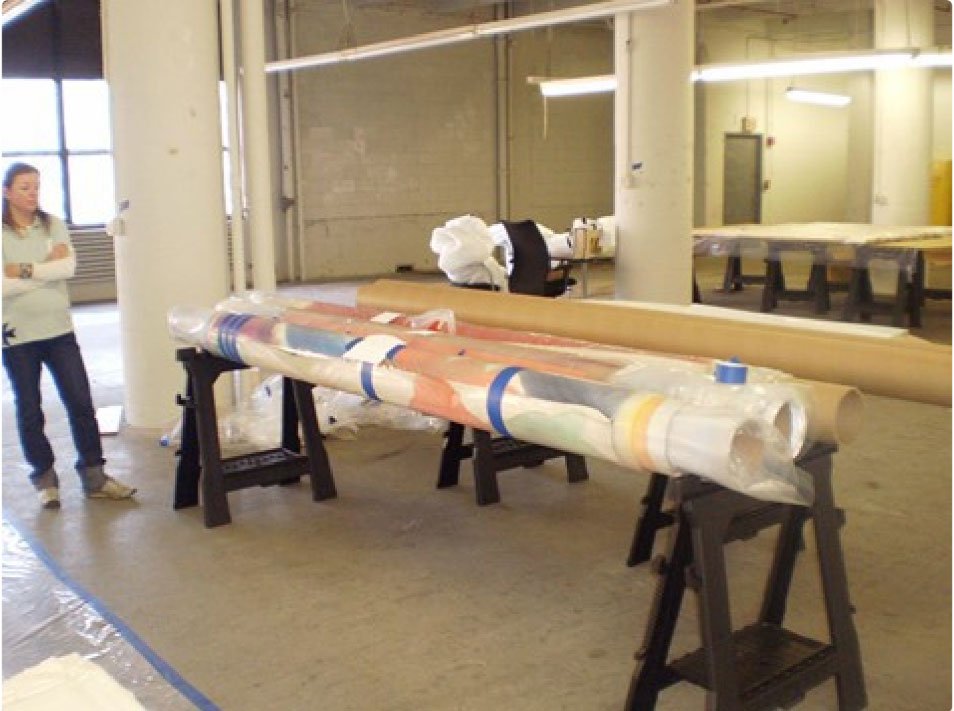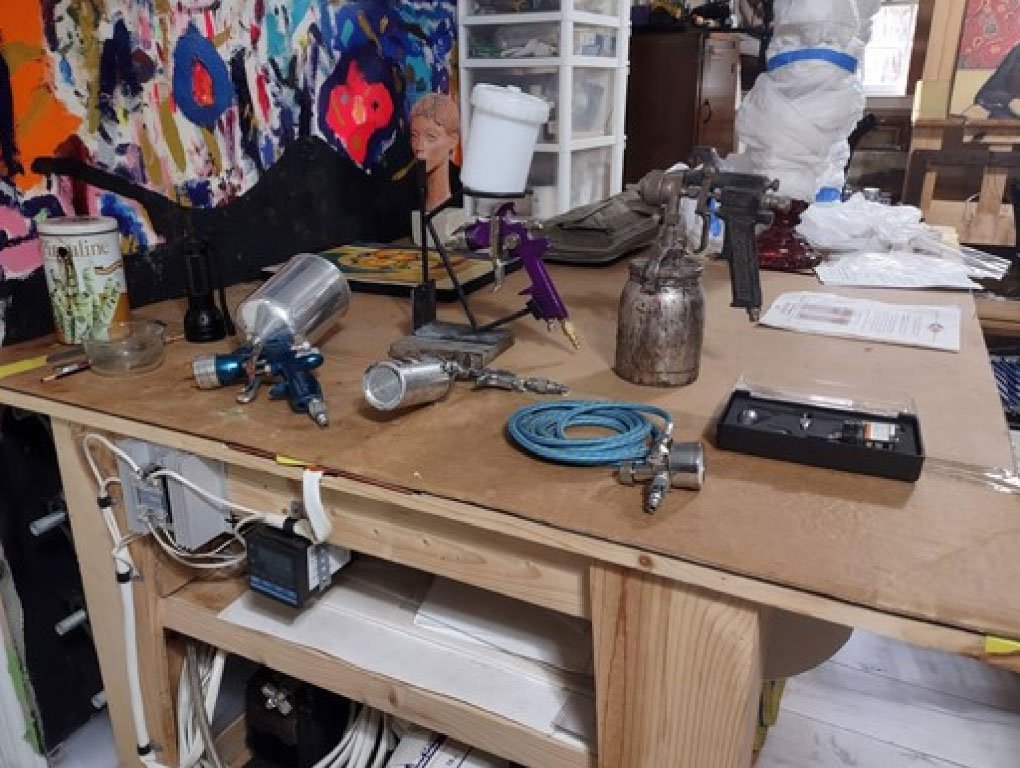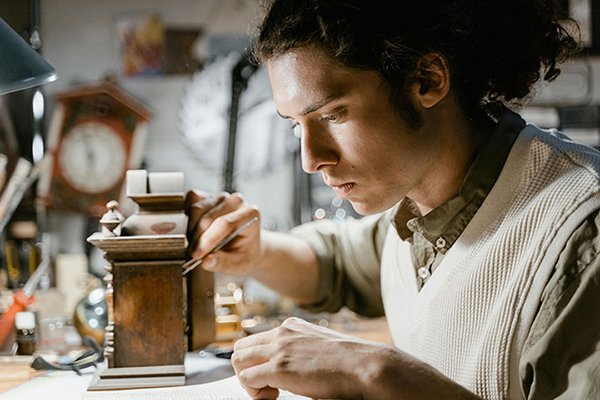Ask a Conservator: Tips, Tricks, and Hacks from Three SERCA Members
by Clara Gonzalez
The Tips and Tricks portion of the SERCA annual meeting is a regular favorite amongst attendees. In this popular segment, professional conservators share personal recommendations and advice, as well as ingenious ways of using or making tools, finding products or applying methodologies. This year was no different thanks to thoughtful and creative insights into the field from David Goist, Larry Shutts, and Sigourney Smuts. Here are some highlights from what they shared:
David Goist Gets Creative in a Pinch
While in NYC following superstorm Sandy in 2012-2013, David Goist undertook an emergency
response and remediation project to help local artist, Ronny Landsfield, store several large canvas
paintings from his studio. Unable to source or afford the required number of acid-free tubes, he and the artist obtained oversized cardboard rolls from a local carpet store. Each tube was wrapped with protective polyethylene sheeting to form an acid-free barrier before rolling multiple paintings onto the tubes in layers.
As David explained, “Ronny was able to put four paintings on each tube, interweaving with
polyethylene as he rolled. He then wrote inventory numbers at the end of each tube.” His paintings were later taken to the Recovery Center established in Brooklyn by FAIC for vacuuming and rolling onto acid-free tubes.

In 2016 David performed a major treatment on a painted theatrical curtain from 1855 that hung at the opening of Thalian Hall in Wilmington, NC. Treatment took place at the Cameron Art Museum where it was placed on exhibition before returning to Thalian Hall. David used a large 12-inch diameter by 20- foot long Sonotube to roll and transport the large theatrical backdrop. Sonotubes are typically used for casting concrete footings in building construction making them a strong and clever product for moving heavy textiles.
These creative methods of storing, moving, and tracking canvas paintings and textiles required quick thinking and ultimately provided a highly effective, and highly affordable, solution with minimal delay.
Larry Shutts Shows Us How to Save With DIY & Dupes
Larry Shutts from Savant and Shutts Art Conservation put on an impressive “gun show” this year,
which concluded with a tour of his lab. During his demonstration, the decades-long professional
shared airbrush product recommendations, discussed how to best achieve a matte finish with a spray gun, and shared his custom-built easels and DIY hot table.
Larry is a conservator in private practice working in a small, shared room with wife and Objects
Conservator Michelle Savant. He is conscientious of how he uses the limited space in his home, taking on tools and equipment with purpose, and only as needed. He’s also a big proponent of working smart with your conservation budget.
During the tour of his lab, he explained this as the reason why he went with a custom-built easel and vacuum hot table for his work with paintings.
The blueprints Larry purchased for the Cadmium Easel from ArtistEaselPlans.com provided step-by- step assembly instructions with pictures, making it easy to follow along. He built the fully customizable and adjustable easel exactly to his specifications, and at a fraction of retail cost. This allows the husband-and-wife pair to work on small-to-larger size canvases as needed, without requiring a large workspace.
Larry’s vacuum hot table is another custom build frequently used in his practice. The large table
measures 48” x 84” and has a 1⁄8” thick aluminum plate. Larry was able to save money by sourcing the metal locally, and he uses a custom-sized, digitally controlled, 240V silicone heat mat he found on eBay. Exploring DIY options and affordable solutions helped Shutts and Savant find the equipment they needed to do the best job within the space they have.

While touring the lab, Larry highlighted the impressive array of airbrush guns he uses in his practice and outlined his preferred application techniques. His number one tip? Don’t overspend on equipment when you don’t have to.
Shutts recommends the Harbor Freight Tools Deluxe Airbrush as an inexpensive, small tool that performs similarly to the Paasche VL. Perfect for fine details, this cost-effective dupe provides ual-
action adjustment like the Paasche VL for just half the price.
Larry went on to demonstrate an arsenal of conservation tools, including the Jam Gun, a narrow-
gauge spray gun used for small to medium size work about 4 inches in diameter. Happy to demonstrate his most reliable tool, his old-fashioned spray gun is able to cover an area of 12 inches in diameter and is used for applying varnishes to large areas. He highlighted other specialized airbrush guns, including a purple spray gun similar to the old-fashioned sprayer, used daily for varnish application.
He explained that in paintings conservation, it is important to apply varnishes in even, thin layers.
Achieving a matte finish can be challenging with a spray gun because it often produces a shine or
creates a powdery surface.
In order to achieve the perfect matte finish, Larry recommends first applying an even layer of varnish and allowing it to dry. Drying time will vary based on the size of canvas, as well as the distance, pressure, and volume of the varnish application. All of these will ultimately contribute to the final finish.
Note: The second coat should be applied a few feet back from the canvas, allowing the particles to travel through the air for a greater distance and enabling the varnish to dry in the air just a moment before it hits the canvas surface. Larry explained that the more pressure and greater distance, the less liquid volume of varnish will hit the canvas surface, further contributing to the final matte finish.
Sigourney Smuts Shows Off Smart Use for a Simple Toy
Today, Sigourney Smuts is an experienced conservator working with the Georgia Archives with a host of professional tools and resources at her disposal. But it wasn’t always that way. As a young
conservator often working under very tight time and budget constraints, Sigourney relied on ingenious thinking to solve problems quickly efficiently and cheaply. When faced with long panoramas, unusually shaped canvases, or odd-sized artworks, Sigourney learned to use modeling plasticine, an oil-based clay, to build up a dam or walled enclosure on a waterproof, non-porous table. In the absence of an appropriately sized traditional water tray, this technique makes it easy to create any size or shape “tray” needed.
With full control over the wall height, shape, and size, this system is particularly useful if you are trying to control the size and amount of fluid used during the washing process. Fast, easy, and cheap to assemble, Sigourney added that a spout can be created by hand or attached to help the dam drain when the project is complete.
Thank you to all who shared during this year’s Tips and Tricks portion. Your creative ideas, DIYs, dupes, and advice are always a great resource to our growing conservation community.
Take care and until next time!

